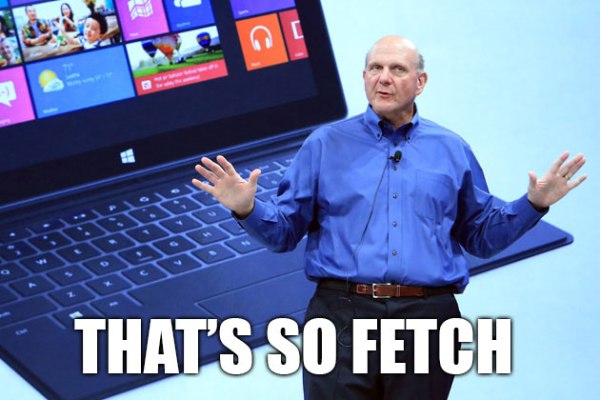Bloomberg is reporting this morning that Microsoft is cutting the price of Windows RT for small tablets in a seemingly desperate bid to spur sales.
It’s a rather predictable move and a touch sad. Tablets based on Windows RT, an operating system that’s pure garbage, are not selling, because, referring to my first point, Windows RT is trash. And since they’re not selling, Microsoft is making concessions and that means cutting the price.
Windows RT was supposed to be Microsoft’s answer to iOS on tablets. Microsoft built the platform to be more robust than the Apple counterpart by including a lot of Windows 8’s desktop tools to run on lower-power devices. But in doing so, Microsoft forked its operating system, forcing developers to choose between Intel-based Windows 8 or ARM-based Windows RT (or Windows Phone 8 or Xbox).
Now, some eight months after Windows RT’s launch, very few mainstream apps have made their way into the Windows Store. There are only a smattering of Windows RT devices available. Meanwhile, Windows 8 devices are quickly becoming as inexpensive as Windows RT.
Microsoft has failed to provide buyers with legitimate reasons to buy a Window RT tablet over an iPad or Android device. Windows RT can run most of Microsoft Office, something traveling shower ring salesmen probably find enticing.
Cutting the price could help.
Android tablets went through the same sort of soul-searching early on, too. For several years, Android tablets were overpriced and without any real reason to exist (remember the HTC Jetstream?).
Then came the $250 B&N Nook Color followed a year later by the Amazon Kindle Fire and the Nexus 7. Suddenly, thanks to their $200 price tag, Android tablets were a viable option for buyers. As popularity exploded Samsung and others cut the price on larger versions, helping to entice more buyers, thus expanding the Android tablet’s market share.
I’m not sure even a $200 tablet could save Windows RT, though.
Computer makers are dropping Windows RT support en mass. HP killed its RT support early on. Samsung followed suit. HTC recently stopped developing its large RT tablet, instead focusing on a smaller, likely 7-inch model. As Bloomberg notes, Dell also has another RT model in the works.
Just the Dell XPS 10, Surface RT and the Asus VivoTab RT carry the Windows RT banner. Lenovo quickly killed its Windows RT-powered IdeaPad Yoga 11. Any other model is too far outside of the mainstream to matter.
Acer just announced the Iconia W3 at Computex. The 8-inch Windows tablet is supposed to hit at 379 Euros later this month. The small-ish tab packs modest specs: 720p display, dual-core Atom Z2760 CPU, 32 or 64GB internal storage with a microSD expansion slot. But it runs Windows 8, not Windows RT.
In fact, at Computex, Taipei’s massive computer tradeshow, there isn’t a hint of Windows RT. And this is the same tradeshow that featured dozens of Windows RT examples last year. The only talk of Windows 8’s lackluster sibling came from Acer’s chairman who told WSJ that Windows RT won’t be “so influential anymore,” also noting that it would be difficult for Windows RT to overcome the lack of compatibility that the full Windows 8 version has.
Windows RT was a mistake from the onset. It’s ridiculous to force consumers to choose between battery life and usability. They’d prefer both. Like on the iPad.
Microsoft can cut prices and perhaps later introduce device subsidies, but it won’t help. Consumers, and more telling, device manufacturers, have spoken. Neither find Windows RT devices to be worth their money. As widely stated at the Surface RT launch, the platform simply has too many compromises.
